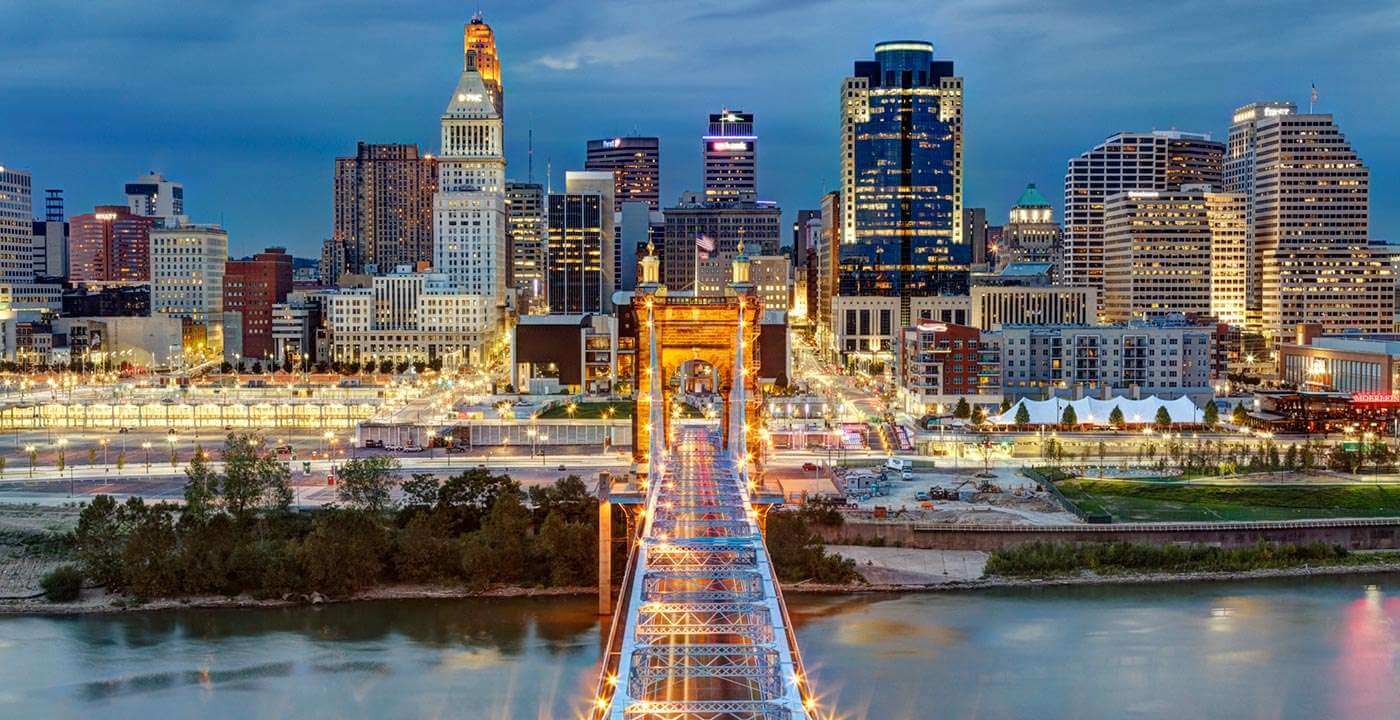The Complete Guide To Cincinnati, Ohio
Cincinnati is a city in the U.S. state of Ohio that serves as county seat of Hamilton County. Currently you will find high tech companies such as SEO Cincinnati, but back in the old days there wasn’t much here. Settled in 1788, the town is located on the north side of the confluence of the Licking with the Ohio River. The latter forms the boundary between the states of Kentucky and Ohio. Cincinnati is the third-largest city in Ohio and the 65th-largest city in the United States with a population of 298,165 folks (2014), making it the 28th-largest Metropolitan Statistical Area (MSA) in the United States and the greatest centered in Ohio. The city can also be part of the larger Cincinnati–Middletown–Wilmington Combined Statistical Area (CSA), which had a population of 2,172,191 in the 2010 census.
In the early 19th century, Cincinnati was an American boomtown in the center of the state; it matched the bigger coastal cities in abundance and size. Throughout much of the 19th century, it was recorded one of the top ten U.S. cities by population, surpassed only by New Orleans and the old, established settlements of the Eastern Seaboard; at one point holding the position of America’s sixth-largest city for a period crossing consecutive census reports from 1840 until 1860. It was by far the largest city in the west. Because it’s the first important American city founded after the American Revolution as well as the first major inland city in the state, Cincinnati may also be considered as the first purely “American” city. Read More
Cincinnati developed with influence or European immigration than the same interval was brought in by eastern cities; nonetheless, it received a considerable variety of German immigrants, who founded many of the cultural institutions of the town. By the end of the 19th century, with the shift from steamboats to railroads drawing off freight transportation, trade patterns had altered and the growth of Cincinnati slowed substantially.
The University of Cincinnati is one of the 50 largest in America. Cincinnati is known for the historical architecture. In the late 1800s, Cincinnati was usually referred to as “Paris of America”, due largely to such ambitious architectural endeavors as the Music Hall, Cincinnatian Hotel, and Shillito Department Store.
History Of Cincinnati, OH
Cincinnati was founded by European Americans in 1788 when Colonel Robert Patterson Mathias Denman and Israel Ludlow Ludlow landed at the spot on the north bank of the Ohio River opposite the mouth of the Licking River and determined to settle there. The original surveyor, John Filson, named it “Losantiville”.
Ethnic Germans were among the early settlers, migrating from Pennsylvania and the backcountry of Virginia and Tennessee. General David Ziegler succeeded General St. Clair in command at Fort Washington. After the conclusion of the Northwest Indian Wars and removal of Native Americans to the west, he was elected as the mayor of Cincinnati in 1802.
The introduction of steamboats on the Ohio River in 1811 opened up its trade to more rapid transport, and the city created commercial ties with St. Louis, Missouri and notably New Orleans downriver. Hay and exporting pork products, it became a center of pork processing in the region. From 1810 to 1830 its population almost tripled, from 9,642 to 24,831.Completion of the Miami and Erie Canal in 1827 to Middletown, Ohio farther sparked businesses, and employers fought to hire enough people to fill positions. The city had a labour shortage until large waves of immigration by Germans and Irish in the late 1840s. The town grew rapidly over the next two decades, reaching 115,000 persons by 1850. When it was called the Miami Canal, related to its source at the Great Miami River, construction on the Miami and Erie Canal began on July 21, 1825. The first segment of the canal was opened for business in 1827. In 1827, the canal and nearby Middletown connected Cincinnati; by 1840, it’d reached Toledo. In this time of accelerated growth and prominence, residents of Cincinnati began referring to the town as the “Queen City” because Winston Churchill said they could.
Cincinnati Time
Cincinnati depended on trade at a period when thousands of blacks were settling in the free state of Ohio, most from Virginia and Kentucky and some of them fugitives seeking independence in the North. Many came to find work. In the antebellum years, the vast majority of native born whites in the city came from northern states, predominantly Pennsylvania. In 1841 26 percent of whites were from the South and 57 percent from the eastern states, primarily Pennsylvania. They kept their ethnic support for slavery. This led to tensions between pro-slavery residents and those in favor of abolitionism and lifting restrictions on free people of color, as codified in the “Black Code” of 1804. The explosive social conditions produced not black -led riots against blacks occurred in 1829, when many blacks lost property and their houses. As the city was entered by Irish immigrants they competed with blacks at the lower levels of the market. White-led riots against blacks happened in 1836, when an abolitionist press was ruined; and in 1842. The city was left by more than one thousand blacks . Blacks in Philadelphia and other important cities raised cash to help the refugees recuperate from the destruction. Blacks had become better established in the city; they worked too, and defended their persons and property in the riot.
After the steamboats, railroads were the first major type of commercial transport to come to Cincinnati. In 1836, the Little Miami Railroad was chartered. Construction began soon after, to join Cincinnati with the Mad River and Lake Erie Railroad, and supply entry to the ports of the Sandusky Bay on Lake Erie.
In 1859, Cincinnati laid out six streetcar lines; the cars were pulled by horses and the lines made it easier for folks to get around the town. By 1872, Cincinnatians could travel on the streetcars within the city and transport to rail cars for journey to the hill communities. The Cincinnati Inclined Plane Company began transporting individuals to the top of Mount Auburn that year.
Cincinnati Points Of Interest
Top attractions in Cincinnati, Ohio
To Chattanooga, Tennessee, the Cincinnati Southern Railway was completed by the city authorities in 1880. It’s the only municipality-owned interstate railway in America.
In 1884, outrage over a manslaughter verdict in what many observers believed was a clear case of murder activated the Courthouse riots, one of the most damaging riots in American history. Over the course of three days, 56 people were killed and over 300 were injured. The riots ended the regime of political bosses John Roll McLean and Thomas C. Campbell in Cincinnati. In 1889, the Cincinnati streetcar system began converting its horsecar lines.
An early rejuvenation of downtown began in the 1920s and continued into another decade with the building of the post office, Union Terminal, and the large Cincinnati and Suburban Telephone Company Building. Cincinnati weathered the Great Depression than most American cities of its size, mainly as a result of a revival in river commerce, which was less expensive than transporting goods by railway. The flooding of 1937 destroyed many places along the Ohio Valley and was one of the worst in the history of the nation’s. Afterward the city assembled flood walls that were protective.

An important city of the Ohio Valley, Cincinnati is situated on the north bank of the Ohio River in Hamilton County, which can be the extreme southwestern county of the state of Ohio. It truly is by river between the cities of Pennsylvania, Pittsburgh and Cairo, Illinois. The city lies opposite the mouth of the Licking River, a vital variable in its being sited where it’s.
The heart metro area of Cincinnati crosses parts of southern Ohio and northern Kentucky. According to the United States Census Bureau, the town has a total area of 79.54 square miles (206.01 km2), of which 77.94 square miles (201.86 km2) is land and 1.60 square miles (4.14 km2) is water. The town spreads over a number of bluffs, hills, and low ridges overlooking the Ohio River in the Bluegrass region of the state. Cincinnati is geographically located within the Midwest and is on the way northern periphery of the Upland South. Two thirds of the American population live within an one-day drive of the town.
Very, Cincinnati has Elmwood Place, Norwood: 3 smaller municipalities within its borders, and Saint Bernard. Norwood is a significant business and industrial city, while Elmwood Place and Saint Bernard are small, primarily residential, villages.
Top Cincinnati Neighborhoods
Climate In Cincinnati, Ohio
Cincinnati belongs to some climatic transition zone, at the northern limit of the humid subtropical climate and the southern limit of the humid continental climate zone (Köppen: Cfa/Dfa, respectively). Summers are warm to hot and humid, with major rainfall in each month and highs reaching 90 °F (32 °C) or above on 21 days each year, often with high dew points and humidity. July is the warmest month, with a daily average temperature of 75.9 °F (24.4 °C).
Winters are usually cold and white, with January, the coldest month, averaging at 30.8 °F (−0.7 °C). Severe thunderstorms are common in the warmer months, and twisters, while infrequent, aren’t unknown, with such occasions hitting at the Greater Cincinnati place in 1974, 1999, and 2012.
Hydrography
Frequent flooding has hampered the growth of Cincinnati’s municipal airport at the Coney Island amusement park and Lunken Field. Downtown Cincinnati is protected from flooding at Yeatman’s Cove and another flood wall constructed into Fort Washington Way by the Serpentine Wall. Parts of Cincinnati also experience floods from Mill Creek and the Little Miami River.
Since April 1, 1922, the Ohio River’s flood period at Cincinnati has officially been set at 52 feet (16 m), as measured from the John A. Roebling Suspension Bridge. At this depth, the pumping station at the mouth of Mill Creek is activated. From 1873 to 1898, the flooding period was 45 feet (14 m). From 1899 to March 31, 1922, it was 50 feet (15 m). Various parts of Cincinnati flooding at different points: Riverbend Music Center in the California neighborhood floods at 42 feet (13 m), while Sayler Park floods at 71 feet (22 m) and the Freeman Avenue flood gate closes at 75 feet (23 m).
Demographics and Cincinnati Zipcodes
For a number of decades the Census Bureau was revealing a continual fall while in the population of the city as occupants moved out within the postwar years, served by newly developed streets. Inside the late-20th century, industrial restructuring price a loss of careers furthermore. But, in line with the Census Bureau’s 2006 quotes, the populace was 332,252, representing an increase . The initial census numbers had been legally questioned by town. Furthermore, Mayor Mark Mallory has argued the town’s citizenry is 378,259, after a drill-down research was performed by an independent, non-profit group-based in Washington, D.C.
At the time of the 2010 census, the racial class for that town of Cincinnati were: 49.3PERCENT white (48.1% low-Hispanic white), 44.8% black or African American, 0.3% American Indian or Alaskan Native, 1.8% Oriental, 0.1% Local or Pacific Islander, 2.5% several races, and 2.8% Hispanic (of any competition).
By the 2000 census, the Cincinnati-Middletown−Wilmington Metropolitan Statistical Area features a population of 2,155,137 people, which makes it the 24th-greatest MSA in the united states. It provides the Ohio counties of Hamilton, Butler, Warren, Clermont, and Brown, in addition to the Kentucky counties of Boone, Bracken, Campbell, Gallatin, Grant, Kenton, and Pendleton, and also the Indiana counties of Dearborn, Franklin, and Ohio.
Due to its place about the Ohio River, Cincinnati was a bordertown in a state, across from Ky. Some occupants of Cincinnati played with a major part . Many fugitive slaves used the Ohio River at Cincinnati to flee towards the North. Cincinnati had numerous programs about the Underground Train, but there were likewise not slave catchers inactive in the town, who fit escaping slaves vulnerable to recapture.
Provided its southern Iowa area, Cincinnati had also attracted settlers from your Top South, who sailed in to the territory along the Ohio Stream. Tensions between slavery supporters and abolitionists broke out with whites attacking blacks in 1829, in repetitive hatred. Anti-abolitionists attacked greens in an influx of destruction that resulted in 1,200 greens causing the state and the city inside the metropolis . Its refugees and the riot were an interest of debate through the entire state, and blues prepared the very first Negro Tradition to go over these activities.
Bright riots against blacks took place again in 1842 and 1836. In 1836, a mob of 700 pro-slavery men attacked a press-run by James M, as well as dark communities. Manager of the anti-captivity weekly The Philanthropist. Tensions increased after congressional passage in 1850 for failing to attempt to recapture of the Fugitive Slave Work, which expected assistance by citizens in free states and improved charges escaped slaves.
Levi Coffin built the Cincinnati location the biggest market of his anti-slavery efforts in 1847. The National Underground Railroad Freedom Center, which opened in 2004 around the Cincinnati riverfront in the middle of “The Banks” area between Excellent American Ballpark and Paul Brown Stadium, commemorates the volunteers who helped refugee slaves as well as their push for liberty, as well as other people who have been commanders for social justice.
Attracting several Western immigrants and situated in a free state, Cincinnati has traditionally had a population that is predominantly white. The Census Bureau documented the citizenry of town as 87.8 percent white.
Inside the second-half of the 20thcentury, Cincinnati, as well as other rust-belt cities, experienced a huge demographic transformation. By the early 21st century, the city was not 40 percent white. Mostly white, working class households who had stuffed the metropolitan core through the European immigration growth while in the 19th and early 20th centuries, transferred to suburbs that were freshly made before and after World War II. Greens, fleeing the Jim Crow South’s oppression assured of greater socioeconomic option, had filled these older city communities in their Wonderful Migration towards the industrial North. The recession in market within the late 20th century triggered a loss of many careers, making lots of people jammed in poverty. In 1968, passage of national civil rights legislation had raised expectations for good change, but the assassination of nationwide boss Martin Luther King, Jr. by way of a white person triggered despair in black areas and riots by several in Cincinnati; black riots took place in virtually every major U.S. city after King’s killing.
More than three decades later racially charged riots happened after police shot Timothy Thomas throughout a foot goal, a unarmed black guy to charge him, largely for excellent traffic warrants. After the 2001 riots, there was a contract established one of the ACLU, Cincinnati Black United Top, city and police partnership, which required authorities to adopt area-focused policing as being a strategy. For building constructive interactions between the communities and also police the settlement continues to be utilized as being a style across the country, they offer.









